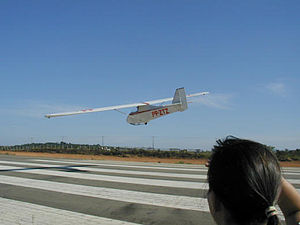CEA-101 CB.1 Gaivota
Jump to navigation
Jump to search
| CB.1 Gaivota | |
|---|---|

| |
| CB.1 Gaivota on approach in 2004 at Brigadeiro Cabral Airport | |
| Role | Sailplane |
| National origin | Brazil |
| Manufacturer | CEA-EEUFMG[1] |
| Designer | Cláudio de Barros |
| First flight | 1963 |
| Introduction | 1965 |
| Number built | 1 |
The CEA-101 CB.1 Gaivota (Brazilian name for the seagull bird), is a single-seat sailplane of high-wing construction designed in 1963 in Brazil.[2]
It was designed by the Portuguese engineer and professor Cláudio de Barros. The CEA-101 was of great importance for the further development of aviation in Minas Gerais. The Minas Gerais Gliding Club used the aircraft as a training aircraft until the early 1980s. After that, the CB.1 was lost in a hangar for a while. In 2001, with the help of former students of DEMEC and aviation friends of CEA, it was restored and since 2003 it is again airworthy with the registration PP-ZTZ.
Specifications
[edit]Data from Pereira 1997, p. 73
General characteristics
- Crew: 1
- Length: 5.52 m (18 ft 1 in)
- Wingspan: 15 m (49 ft 3 in)
- Upper wingspan: 10.2 m (33 ft 6 in)
- Wing area: 10.22 m2 (110.0 sq ft)
- Empty weight: 190 kg (419 lb)
- Max takeoff weight: 280 kg (617 lb)
Performance
- Stall speed: 65 km/h (40 mph, 35 kn)
- Never exceed speed: 260 km/h (160 mph, 140 kn)
- Maximum glide ratio: 1.38 at 90 km/h (56 mph)
- Rate of sink: 0.89 m/s (175 ft/min)
- Wing loading: 17.8 kg/m2 (3.6 lb/sq ft)
Notes
[edit]- ^ Simons, Martin (2005). Sailplanes 1965 - 2000. Königswinter: EQIP Werbung & Verlag GmbH. pp. 16–17. ISBN 3 9808838 1 7.
- ^ Pereira, Roberto (1997). Enciclopédia de Aviões Brasileiros. São Paulo: Editora Globo. p. 73. ISBN 8525021377.